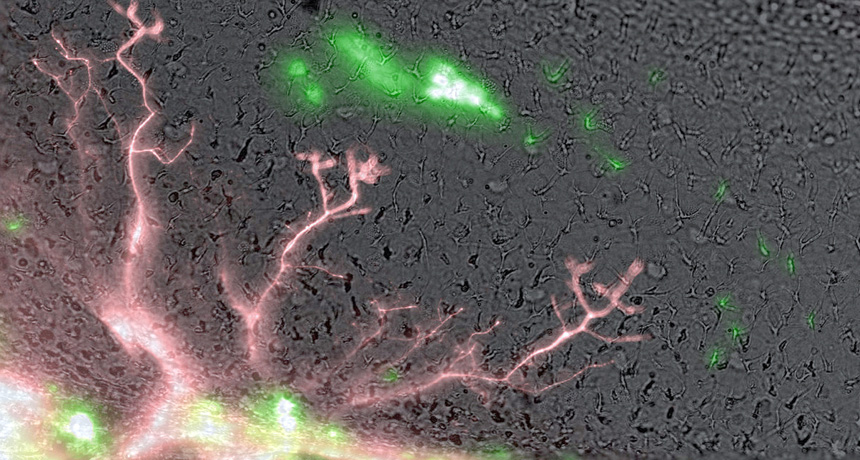A nervy strategy for transplants
Tweaking electric charges helps rewire transplanted organs — at least in tadpoles

The tendrils in pink are nerve axons reaching out from a transplanted eye. The cells in green have electric charges on their membranes that keep the axons from growing.
DOUGLAS J. BLACKISTON
What has three eyes, breathes through gills, and may help scientists spot new ways to improve organ transplants? An unusual tadpole living in a lab near Boston, Mass.
Researchers removed an eye from one tadpole’s head and attached it to the skin of another. Adjusting electric charges in that second tadpole’s cells helped its new, third eye connect to its new body. The adjustments triggered the attached eye to grow new nerve cells, which carry electrical signals. Those nerve cells reached into the recipient tadpole’s skin. And those infiltrating cells created pathways to transmit signals between the new eye and the body.
This technique could help scientists learn how to make transplanted eyes, ears and other organs better communicate with other tissues in a new host.
Scientists didn’t think such an accomplishment was possible, notes biologist Sylvia Chifflet, who was not a part of the new study. “We used to think that the nervous system, once severed, would not regenerate,” she told Science News. Chifflet works at Universidad de la República medical school. It’s in Montevideo, the capital of the South American nation of Uruguay.
Biologist Michael Levin works at Tufts University in Medford, Mass. He and his coworkers had shown that electric charges play an important role in how organs, such as the eyes, develop. For their latest study, they removed the left eye from one tadpole and attached it near the tail of another tadpole. The eye grew, but it didn’t communicate with its host.
That made sense, they realized, because the new eye wasn’t growing many new axons. An axon is the threadlike part of a nerve cell. For electrical signals to move between nerve cells, or from nerve cells to other cells (such as muscle cells), those signals must travel along axons. In theory, a transplanted organ could hack into its host’s nervous system by growing axons that connect with the host’s cells.
Hoping to do that, the scientists experimented with electric charges. All cells build up such a charge along their membranes, or outer layers. That charge is called the membrane voltage potential. The amount of charge rises or falls as charged particles move into and out of the cells. Levin’s team suspected those charges slowed or stopped the growth of axons from the newly transplanted eye. So they cleared out the charges.
To do this, they bathed the tadpoles in a drug. Doctors normally use this medicine to wipe out parasites. Here, though, that drug wiped out the charges on the cell membranes. Levin likened it to draining a battery. And the trick worked: The eye began to grow many axons that reached into the tadpole’s body. Then the scientists tried the opposite: They boosted the charges on the cell membranes. The now-supercharged layers stopped the growth of the axons. They acted like an electric fence that penned them in.
Levin’s team reported its dramatic new findings December 1 in Neurotherapeutics.
“Our future goal is to … make nerves go where we want them to,” Levin told Science News.
The technique hasn’t been tested on other organisms. And that’s important, because tadpoles are very different from people. Still, the work “raises the possibility that someday there might be a way to regenerate lost organs,” Donald Ingber told Science News. A bioengineer at Harvard University in Boston, Mass., he did not take part in the new study. “The only chance of ever doing this [regenerating lost organs in people],” he argues, is by first probing, as they did here, the basic biology of how this process works.
Power Words
axon The long, tail-like extension of a neuron that conducts electrical signals away from the cell.
cell The smallest structural and functional unit of an organism. Typically too small to see with the naked eye,it consists of watery fluid surrounded by a membrane or wall. Animals are made of anywhere from thousands to trillions of cells, depending on their size.
cell membrane Separates the inside of a cell from the outside of it. Some particles are permitted to pass through the membrane.
electric charge The physical property responsible for electric force; it can be negative or positive.
nerves Long, delicate fibers that communicate across the body of an animal. An animal’s backbone contains many nerves, some of which control the movement of its legs or fins, and some of which convey sensations such as hot, cold, and pain.
nervous system The network of nerve cells and fibers that transmits signals between parts of the body.
parasite An organism that gets benefits from another species, called a host, but doesn’t provide it any benefits. Classic examples of parasites include ticks, fleas, and tapeworms.
voltage A force associated with an electric current that is measured in units known as volts. Power companies use high-voltage to move electric power over long distances.







